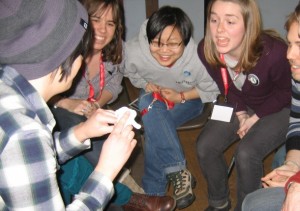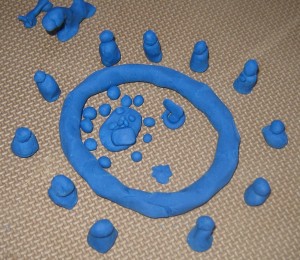May 09, 2012 Learning Through Play with Playdough Pictionary: Blending Community Building With Academic or Training Content Review
 Playdough Pictionary
Playdough Pictionary
Playdough Pictionary has been one of my favorite “go-to” activities for years. Though I first started using it in team-building programs I found that it is an active, multi-sensory approach to curricular content review as well as a community and group building activity. The game encourages creativity, consensus building, social interaction, communication, cooperation, appreciation of others, play, and pro-social group work. This is a playful approach to differentiation, and can be a fun and useful formative assessment.
Facilitation Suggestions:
Divide participants into groups of 5-6 using the partner “consensus” method to divide (See April 2010 Post).
- Invite each group to select a “team name” (practicing consensus/decision-making) possibly using a topic area related to what you are studying in class or reviewing in training. Inviting group members to choose team names with a reasonable structure is a playful way to give them a sense of ownership.
- Give each group a can of play dough.
- Invite each group to select a first sculptor.
- The sculptors from each team go to the leader/facilitator who gives participants a word such as bike, ice cream cone, whale, giraffe, etc. to the sculptors. For curricular content review use objects and concepts from a lesson you are teaching such as rock formations, tectonic plate theory, parts of a cell, geography, geometry terms etc.
- The sculptors then return to their teams to sculpt the object for their teammates who try to guess what it is before the other teams figure out what their own sculptor is making.
- The group that guesses correctly wins that round. I have the team members raise their hands when their team guesses the word as a visual cure for me as the leader to “judge” the winners during this fast paced game.
- Give each group an opportunity to show off their sculpture and receive appreciation from their classmates/group members.
- A new sculptor from each team then comes up for the next word. Like many competitive games turn-taking is part of the lesson. This is a great opportunity for younger participants to practice the important skill of compromise, patience, self-regulation and taking turns. More reluctant group members don’t have to take a turn as a sculptor. There is choice involved in this activity about the roles participants take. Guessing is as important as sculpting.
- In the academic review version, in order to truly differentiate, have students who are feeling confident in their knowledge of the material run the game instead of the teacher/facilitator.
- I regularly invite individuals to switch teams throughout the game(for example every other turn I’ll ask “anyone who has blue on”, or “anyone with a spring birthday” to go to the team next to them clockwise). This increases the cooperative aspects of the activity and maximizes the movement and social interaction. I don’t keep score, and groups rarely notice as they are caught up in the play itself!

Outcomes Processing Ideas:
This has worked beautifully for me in the classroom. My first success using this specifically around academic content occurred when a colleague of mine asked me to come into her Earth Science class to facilitate group building activities. I knew she was also feeling pressure about meeting her content goals so we combined this with a curricular content review.
The group was studying rock formations. So, I asked for student volunteers who felt like they had a good knowledge of the rocks formations they had been studying. Three boys readily volunteered to come up with the terms for their classmates and run the game. Their teacher and I watched on the sidelines as they facilitated the game for their peers who were actively engaged throughout. The interesting thing was that the student volunteers were not the usual “hand raisers” in class. Their teacher was pleasantly surprised at their level of knowledge. As she observed, the game became a formative assessment to gauge all of the students readiness for the upcoming quiz. Over the years I have continued to use this in the classroom as a form of differentiated review and formative assessment.
This is not only a fun way to review academic material but can be an opportunity for participants to get comfortable working with others in groups. It is a wonderful way to get groups thinking about creativity and its importance in solving everyday problems from math, science, to a conflict with a peer. I have found this conversation about creativity can empower people of ages with the knowledge they have it and can use it everyday (See Tips & Tools: The Art of Experiential Group Facilitation).
This game is also a strategy to practice positive social play, addressing healthy competition, and behavioral norms for group play. Participants can practice showing appreciation for other’s work by applauding for winning team’s sculpture, losing gracefully and learning to appreciate the process of play over winning. I never keep score and most groups don’t even notice.
References:
I adapted this activity from a game listed in Quicksilver by Karl Rohnke and Steve Butler who credited Ann Driscoll of the University of New Hampshire Brown Center. This variation appears in Tips & Tools: The Art of Experiential Group Facilitation.
Rohnke, Karl (1995) Quicksilver. Dubuque, IA: Kendall Hunt Publishing.
Stanchfield, Jennifer (2007) Tips and Tools for the Art of Experiential Group Facilitation. OKC, OK: Wood ‘N’ Barnes Publishing Co.



No Comments